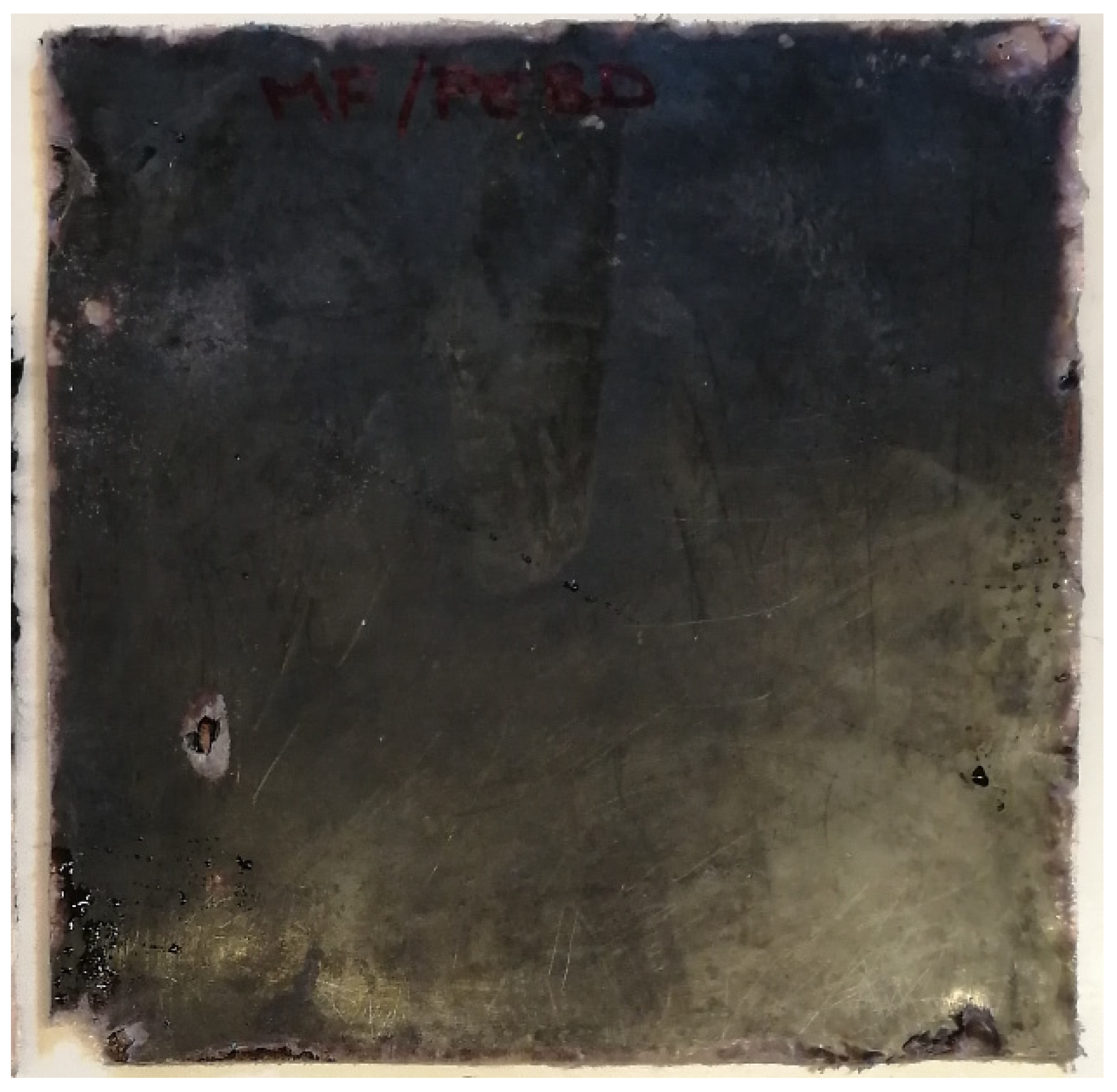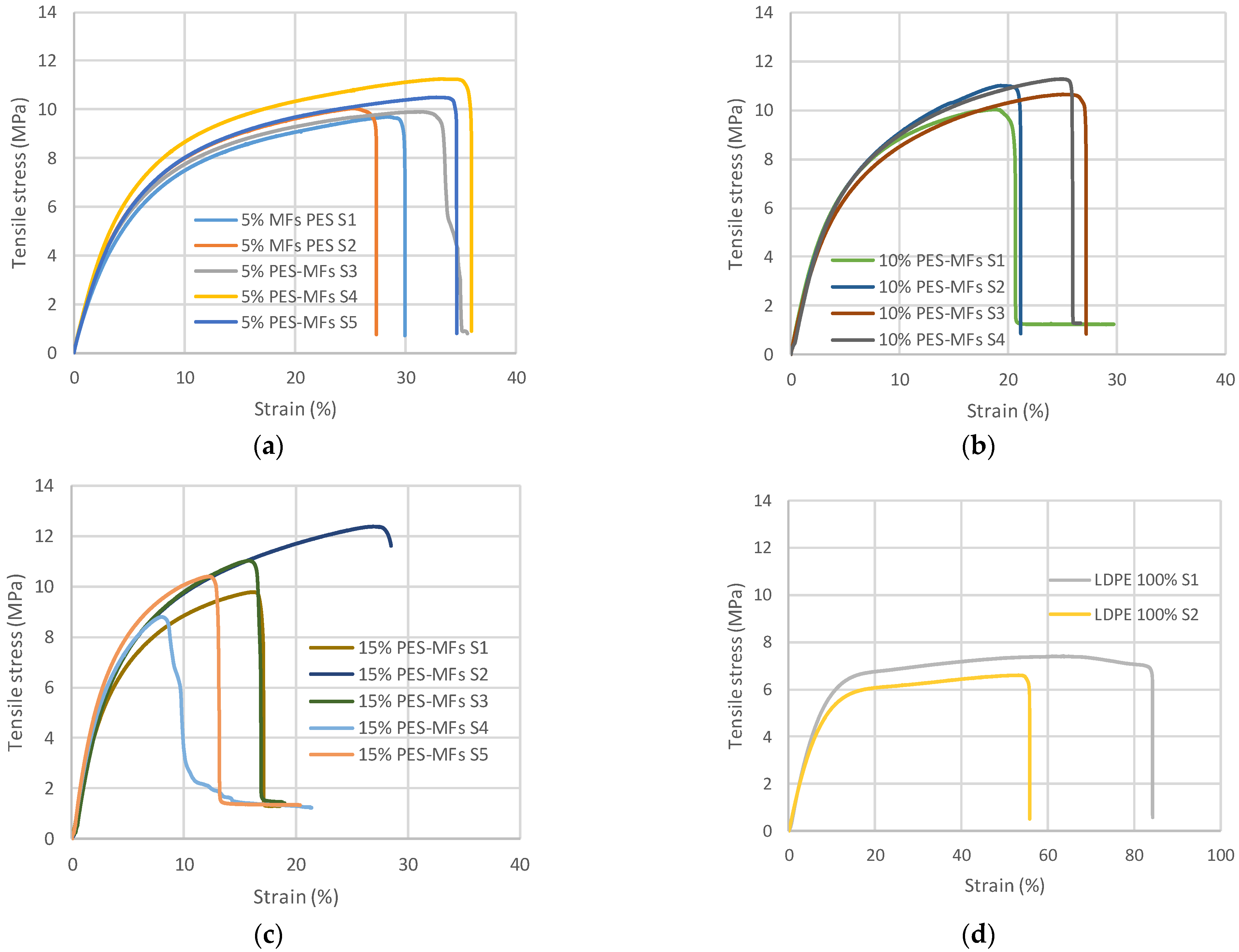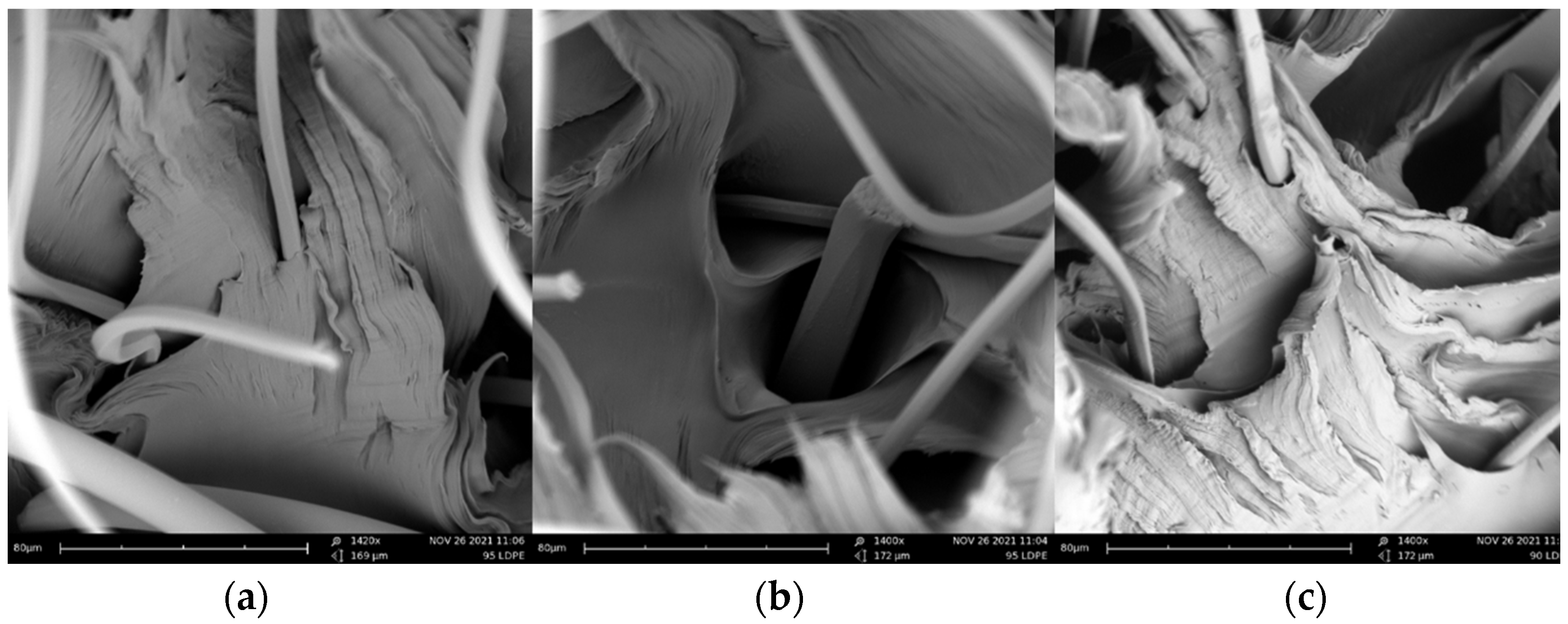Novel Treatment to Immobilize and Use Textiles Microfibers Retained in Polymeric Filters through Their Incorporation in Composite Materials
Abstract
:1. Introduction
2. Materials and Methods
2.1. Composites Manufacturing
2.2. Tensile Test
2.3. SEM Images
3. Results
3.1. Composites
3.2. Tensile Tests Outcomes
- EC: Young’s modulus of the composite;
- VF: volume of MFs included in the matrix;
- EM: Young’s modulus of the LDPE (0.09 GPa, experimentally obtained)
- VM: volume of LDPE included in the matrix.
3.3. SEM Images
3.4. Practical Solution
4. Conclusions
Author Contributions
Funding
Institutional Review Board Statement
Informed Consent Statement
Data Availability Statement
Conflicts of Interest
References
- Belzagui, F.; Gutiérrez-Bouzán, C. Review on alternatives for the reduction of textile microfibers emission to water. J. Environ. Manag. 2022, 317, 115347. [Google Scholar] [CrossRef] [PubMed]
- Cotton, L.; Hayward, A.S.; Lant, N.J.; Blackburn, R.S. Improved garment longevity and reduced microfibre release are important sustainability benefits of laundering in colder and quicker washing machine cycles. Dye. Pigment. 2020, 177, 108120. [Google Scholar] [CrossRef]
- De Falco, F.; Gullo, M.P.; Gentile, G.; Di Pace, E.; Cocca, M.; Gelabert, L.; Brouta-Agnésa, M.; Rovira, A.; Escudero, R.; Villalba, R.; et al. Evaluation of microplastic release caused by textile washing processes of synthetic fabrics. Environ. Pollut. 2018, 236, 916–925. [Google Scholar] [CrossRef]
- ECHA. Restriction Report-Proposal. 2019. Available online: https://echa.europa.eu/registry-of-restriction-intentions/-/dislist/details/0b0236e18244cd73 (accessed on 15 January 2022).
- Chen, G.; Li, Y.; Wang, J. Occurrence and ecological impact of microplastics in aquaculture ecosystems. Chemosphere 2021, 274, 129989. [Google Scholar] [CrossRef] [PubMed]
- Boucher, J.; Friot, D. Primary Microplastics in the Oceans: A Global Evaluation of Sources; IUCN: Gland, Switzerland, 2017. [Google Scholar] [CrossRef]
- Belzagui, F.; Buscio, V.; Gutiérrez-Bouzán, C.; Vilaseca, M. Cigarette butts as a microfiber source with a microplastic level of concern. Sci. Total Environ. 2020, 762, 144165. [Google Scholar] [CrossRef]
- Zhou, H.; Zhou, L.; Ma, K. Microfiber from textile dyeing and printing wastewater of a typical industrial park in China: Occurrence, removal and release. Sci. Total Environ. 2020, 739, 140329. [Google Scholar] [CrossRef]
- Belzagui, F.; Crespi, M.; Álvarez, A.; Gutiérrez-Bouzán, C.; Vilaseca, M. Microplastics’ emissions: Microfibers’ detachment from textile garments. Environ. Pollut. 2019, 248, 1028–1035. [Google Scholar] [CrossRef]
- De Falco, F.; Di Pace, E.; Cocca, M.; Avella, M. The contribution of washing processes of synthetic clothes to microplastic pollution. Sci. Rep. 2019, 9, 6633. [Google Scholar] [CrossRef]
- Collignon, A.; Hecq, J.-H.; Galgani, F.; Voisin, P.; Collard, F.; Goffart, A. Neustonic microplastic and zooplankton in the North Western Mediterranean Sea. Mar. Pollut. Bull. 2012, 64, 861–864. [Google Scholar] [CrossRef] [Green Version]
- Fossi, M.C.; Coppola, D.; Baini, M.; Giannetti, M.; Guerranti, C.; Marsili, L.; Panti, C.; de Sabata, E.; Clò, S. Large filter feeding marine organisms as indicators of microplastic in the pelagic environment: The case studies of the Mediterranean basking shark (Cetorhinus maximus) and fin whale (Balaenoptera physalus). Mar. Environ. Res. 2014, 100, 17–24. [Google Scholar] [CrossRef]
- GESAMP. Sources, Fate and Effects of Microplastics in the Marine Environment: A Global Assessment. 2015. Available online: http://ec.europa.eu/environment/marine/good-environmental-status/descriptor-10/pdf/GESAMP_microplasticsfullstudy.pdf (accessed on 15 January 2022).
- Keshavarzifard, M.; Vazirzadeh, A.; Sharifinia, M. Occurrence and characterization of microplastics in white shrimp, Metapenaeus affinis, living in a habitat highly affected by anthropogenic pressures, northwest Persian Gulf. Mar. Pollut. Bull. 2021, 169, 112581. [Google Scholar] [CrossRef] [PubMed]
- Rochman, C.M.; Kurobe, T.; Flores, I.; Teh, S.J. Early warning signs of endocrine disruption in adult fish from the ingestion of polyethylene with and without sorbed chemical pollutants from the marine environment. Sci. Total Environ. 2014, 493, 656–661. [Google Scholar] [CrossRef] [PubMed]
- Jemec, A.; Horvat, P.; Kunej, U.; Bele, M.; Kržan, A. Uptake and effects of microplastic textile fibers on freshwater crustacean Daphnia magna. Environ. Pollut. 2016, 219, 201–209. [Google Scholar] [CrossRef] [PubMed]
- Welden, N.A.; Cowie, P.R. Environment and gut morphology influence microplastic retention in langoustine, Nephrops norvegicus. Environ. Pollut. 2016, 214, 859–865. [Google Scholar] [CrossRef] [PubMed] [Green Version]
- Nelms, S.E.; Galloway, T.S.; Godley, B.J.; Jarvis, D.S.; Lindeque, P.K. Investigating microplastic trophic transfer in marine top predators. Environ. Pollut. 2018, 238, 999–1007. [Google Scholar] [CrossRef]
- Weis, J.S.; Palmquist, K.H. Reality Check: Experimental Studies on Microplastics Lack Realism. Appl. Sci. 2021, 11, 8529. [Google Scholar] [CrossRef]
- Rochman, C.M.; Scherer, C.; Alvarez-Muñoz, D.; Brennholt, N.; Bourrain, X.; Buchinger, S.; Fries, E.; Grosbois, C.; Klasmeier, J.; Marti, T.; et al. Plastics and Priority Pollutants: A Multiple Stressor in Aquatic Habitats. Environ. Sci. Technol. 2013, 47, 2439–2440. [Google Scholar] [CrossRef]
- Rochman, C.M.; Browne, M.A.; Halpern, B.S.; Hentschel, B.T.; Hoh, E.; Karapanagioti, H.K.; Rios-Mendoza, L.M.; Takada, H.; Teh, S.; Thompson, R.C. Policy: Classify plastic waste as hazardous. Nature 2013, 494, 169–171. [Google Scholar] [CrossRef] [PubMed]
- Van Cauwenberghe, L.; Janssen, C. Microplastics in bivalves cultured for human consumption. Environ. Pollut. 2014, 193, 65–70. [Google Scholar] [CrossRef] [PubMed]
- Rochman, C.M.; Kross, S.M.; Armstrong, J.B.; Bogan, M.T.; Darling, E.S.; Green, S.J.; Smyth, A.R.; Veríssimo, D. Scientific Evidence Supports a Ban on Microbeads. Environ. Sci. Technol. 2015, 49, 10759–10761. [Google Scholar] [CrossRef] [Green Version]
- Yang, Y.; Yang, J.; Wu, W.-M.; Zhao, J.; Song, Y.; Gao, L.; Yang, R.; Jiang, L. Biodegradation and Mineralization of Polystyrene by Plastic-Eating Mealworms: Part 2. Role of Gut Microorganisms. Environ. Sci. Technol. 2015, 49, 12087–12093. [Google Scholar] [CrossRef] [PubMed]
- Schymanski, D.; Goldbeck, C.; Humpf, H.-U.; Fürst, P. Analysis of microplastics in water by micro-Raman spectroscopy: Release of plastic particles from different packaging into mineral water. Water Res. 2018, 129, 154–162. [Google Scholar] [CrossRef] [PubMed]
- Cox, K.D.; Covernton, G.A.; Davies, H.L.; Dower, J.F.; Juanes, F.; Dudas, S.E. Human Consumption of Microplastics. Environ. Sci. Technol. 2019, 53, 7068–7074. [Google Scholar] [CrossRef] [PubMed] [Green Version]
- Oßmann, B.E. Microplastics in drinking water? Present state of knowledge and open questions. Curr. Opin. Food Sci. 2021, 41, 44–51. [Google Scholar] [CrossRef]
- Rainieri, S.; Barranco, A. Microplastics, a food safety issue? Trends Food Sci. Technol. 2018, 84, 55–57. [Google Scholar] [CrossRef]
- Domenech, J.; Marcos, R. Pathways of human exposure to microplastics, and estimation of the total burden. Curr. Opin. Food Sci. 2021, 39, 144–151. [Google Scholar] [CrossRef]
- Li, Q.; Ma, C.; Zhang, Q.; Shi, H. Microplastics in shellfish and implications for food safety. Curr. Opin. Food Sci. 2021, 40, 192–197. [Google Scholar] [CrossRef]
- Vázquez-Rowe, I.; Ita-Nagy, D.; Kahhat, R. Microplastics in fisheries and aquaculture: Implications to food sustainability and safety. Curr. Opin. Green Sustain. Chem. 2021, 29, 100464. [Google Scholar] [CrossRef]
- Prata, J.C.; da Costa, J.P.; Lopes, I.; Andrady, A.L.; Duarte, A.C.; Rocha-Santos, T. A One Health perspective of the impacts of microplastics on animal, human and environmental health. Sci. Total Environ. 2021, 777, 146094. [Google Scholar] [CrossRef]
- CoraBall. The Cora Ball. 2019. Available online: https://coraball.com/ (accessed on 20 May 2019).
- Lint LUV-R, MicroPlastics Lint LUV-R Washing Machine Discharge Filter, Environ. Enhanc. 2021. Available online: https://environmentalenhancements.com/store/index.php/products/products-lint-filter (accessed on 22 January 2021).
- Napper, I.E.; Barrett, A.C.; Thompson, R.C. The efficiency of devices intended to reduce microfibre release during clothes washing. Sci. Total Environ. 2020, 738, 140412. [Google Scholar] [CrossRef]
- Year, T.F. The Fiber Year 2018. In World Survey on Textiles & Nonwovens; The Fiber Year Consulting: Roggwil, Switzerland, 2018; Volume 18. [Google Scholar]
- Exchange, T. Preferred Fiber & Materials Market Report 2020 Welcome to the 2020 Preferred Fiber & Materials Market Report. 2020. Available online: https://textileexchange.org/wp-content/uploads/2020/06/Textile-Exchange_Preferred-Fiber-Material-Market-Report_2020.pdf%0Ahttps://textileexchange.org/2020-preferred-fiber-and-materials-market-report-pfmr-released/ (accessed on 15 January 2022).
- ASTM International. ASTM D638-14: Standard Test Method for Tensile Properties of Plastics. 2014. Available online: www.astm.org (accessed on 15 January 2022).
- Kiran, M.D.; Sukruth, K.; Govindaraju, H.K.; Lokesh Yadhav, B.R. Tensile and impact strength of nickel coated short carbon fiber reinforced polyester composite. Mater. Today Proc. 2021, 52, 1011–1013. [Google Scholar] [CrossRef]
- Gunduz, G.; Erol, D.; Akkas, N. Mechanical Properties of Unsaturated Polyester-Isocyanate Hybrid Polymer Network and Its E-Glass Fiber-reinforced Composite. J. Compos. Mater. 2005, 39, 1577–1589. [Google Scholar] [CrossRef]
- Rajan, R.; Riihivuori, J.; Rainosalo, E.; Skrifvars, M.; Järvelä, P. Effect of viscose fabric modification on the mechanical and water absorption properties of composites prepared through vacuum infusion. J. Reinf. Plast. Compos. 2014, 33, 1416–1429. [Google Scholar] [CrossRef]
- Basu, S. Tensile Deformation of Fibers Used in Textile Industry. Agil. Technol. 2012. Available online: https://www.keysight.com/es/en/assets/7018-03436/application-notes/5991-0274.pdf (accessed on 10 December 2021).
- William, D.C.J.; Rethwisch, D.G. Composites. In Materials Science and Engineering: An Introduction, 10th ed.; Wiley: New York, NY, USA, 2018; pp. 577–617. [Google Scholar]
- Granda, L. Evaluación De Las Propiedades De Materiales Compuestos Fabricados a Partir De Fibras Semiquímicas De Leu-caena Collinsii y Polipropileno, Universitat de Girona. 2016. Available online: http://hdl.handle.net/10803/398953http://creativecommons.org/licenses/by/4.0/deed.ca (accessed on 15 January 2022).
- Sular, V.; Öner, E.; Okur, A. Roughness and frictional properties of cotton and polyester woven fabrics. Indian J. Fibre Text. Res. 2014, 38, 349–356. [Google Scholar]
- Sun, D.; Stylios, G. Fabric surface properties affected by low temperature plasma treatment. J. Mater. Process. Technol. 2006, 173, 172–177. [Google Scholar] [CrossRef]
- PlascticEurope. Plastics–the Facts 2020. 2020. Available online: https://www.plasticseurope.org/application/files/3416/2270/7211/Plastics_the_facts-WEB-2020_versionJun21_final.pdf%0Ahttps://www.plasticseurope.org/en/resources/publications/4312-plastics-facts-2020 (accessed on 15 January 2022).
- EuRIC AISBL. Recycling: Bridging Circular Economy & Climate Policy. 2020. Available online: https://www.euric-aisbl.eu/position-papers/download/680/381/32 (accessed on 15 January 2022).
- Belzagui, F.; Gutiérrez-Bouzán, C.; Álvarez-Sánchez, A.; Vilaseca, M. Textile microfibers reaching aquatic environments: A new estimation approach. Environ. Pollut. 2020, 265, 114889. [Google Scholar] [CrossRef]




Publisher’s Note: MDPI stays neutral with regard to jurisdictional claims in published maps and institutional affiliations. |
© 2022 by the authors. Licensee MDPI, Basel, Switzerland. This article is an open access article distributed under the terms and conditions of the Creative Commons Attribution (CC BY) license (https://creativecommons.org/licenses/by/4.0/).
Share and Cite
Belzagui, F.; Gutiérrez-Bouzán, C.; Carrillo-Navarrete, F. Novel Treatment to Immobilize and Use Textiles Microfibers Retained in Polymeric Filters through Their Incorporation in Composite Materials. Polymers 2022, 14, 2971. https://doi.org/10.3390/polym14152971
Belzagui F, Gutiérrez-Bouzán C, Carrillo-Navarrete F. Novel Treatment to Immobilize and Use Textiles Microfibers Retained in Polymeric Filters through Their Incorporation in Composite Materials. Polymers. 2022; 14(15):2971. https://doi.org/10.3390/polym14152971
Chicago/Turabian StyleBelzagui, Francisco, Carmen Gutiérrez-Bouzán, and Fernando Carrillo-Navarrete. 2022. "Novel Treatment to Immobilize and Use Textiles Microfibers Retained in Polymeric Filters through Their Incorporation in Composite Materials" Polymers 14, no. 15: 2971. https://doi.org/10.3390/polym14152971
APA StyleBelzagui, F., Gutiérrez-Bouzán, C., & Carrillo-Navarrete, F. (2022). Novel Treatment to Immobilize and Use Textiles Microfibers Retained in Polymeric Filters through Their Incorporation in Composite Materials. Polymers, 14(15), 2971. https://doi.org/10.3390/polym14152971





